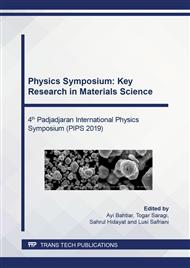[1]
K. Nagamine, Introductory Muon Science, Cambridge University Press, (2003).
Google Scholar
[2]
D.C. Walker, Muon and Muonium Chemistry, Cambridge University Press, (1983).
Google Scholar
[3]
S. Han, K. Wang, M. Willis, L. Nuccio, F.L. Pratt, J.S. Lord, JK.J. Thorley, J. Anthony, A.J. Drew, S. Zhang, L. Schulz, Muonium avoided level crossing measurement of electron spin relaxation rate in a series of substituted anthradithiophene based molecules, Synth. Metals 208 (2015) 39-42.
DOI: 10.1016/j.synthmet.2015.04.020
Google Scholar
[4]
J.S. Möller, P. Bonfà, D. Ceresoli, F. Bernardini, S.J. Blundell, T. Lancaster, R. De Renzi, N. Marzari, I. Watanabe, S. Sulaiman, M.I. Mohamed-Ibrahim, Playing quantum hide-and-seek with the muon: localizing muon stopping sites, Phys. Scr. 88 (2013) 068510.
DOI: 10.1088/0031-8949/88/06/068510
Google Scholar
[5]
S. Sulaiman, First Principles Investigation of Electronic Structures and Hyperfine Properties of Semiconductors and High Critical Transition Temperature Superconductors, PhD Thesis, (1992).
Google Scholar
[6]
W. Weltner, Magnetic Atoms and Molecules, Dover Publications, (1989).
Google Scholar
[7]
K.V. Berezin, V.V. Nechaev, Comparison of theoretical methods and basis sets for ab initio and DFT calculations of the structure and frequencies of normal vibrations of polyatomic molecules, J. Appl. Spectrosc., 71 (2004) 164-172.
DOI: 10.1023/b:japs.0000032870.02752.5e
Google Scholar
[8]
L. Hermosilla, P. Calle, J.M. García de La Vega, C. Sieiro, Density functional theory predictions of isotropic hyperfine coupling constants, J. Phys. Chem. A 109 (2005) 1114-1124.
DOI: 10.1021/jp0466901
Google Scholar
[9]
B. O. Milhoj, E.D. Hedegard, S.P.A. Sauer, On the use of locally dense basis sets in the calculation of EPR hyperfine couplings: a study on model systems for bio-inorganic Fe and Co complexes, Curr. Inorg. Chem. 3 (2013) 270-283.
DOI: 10.2174/1877944103666140110225818
Google Scholar
[10]
W.N. Zaharim, S. Sulaiman, S.N. Abu Bakar, N.E. Ismail, H. Rozak, I. Watanabe, The effects of split valence basis sets on muon hyperfine interaction in guanine nucleobase and nucleotide structures, Mater. Sci. Forum 966 (2019) 222-228.
DOI: 10.4028/www.scientific.net/msf.966.222
Google Scholar
[11]
P.L. Toh, S. Sulaiman, M. Ibrahim, M. Ismail, L.S. Ang, Density functional theory studies of electronic structures and hyperfine interactions of muonium in imidazole, Appl. Mech. Mater. 749 (2015) 134-138.
DOI: 10.4028/www.scientific.net/amm.749.134
Google Scholar
[12]
P.L. Hubbard, V.S. Oganesyan, N. Sulaimanov, J.N. Butt, U.A. Jayasooriya, Avoided level crossing muon spectroscopy of free radicals formed by muonium addition to the constituents of DNA, J. Phys. Chem. A 108 (2004) 9302-9309.
DOI: 10.1021/jp0475335
Google Scholar
[13]
I. McKenzie, Hydrogen-atom addition to nucleobases in the solid state: characterization of the corresponding muoniated radicals using μSR, J. Phys. Chem. B 123 (2019) 4540-4549.
DOI: 10.1021/acs.jpcb.9b02930
Google Scholar
[14]
P.L. Hubbard, A. Tani, V.S. Oganesyan, J.N. Butt, S.P. Cottrell, U.A. Jayasooriya, Different responses to muon implantation in single-and double-stranded DNA, Physica B Condens. Matter. 374 (2006) 437-440.
DOI: 10.1016/j.physb.2005.11.126
Google Scholar
[15]
J.A. Plumley, J.J. Dannenberg, A comparison of the behavior of functional/basis set combinations for hydrogen-bonding in the water dimer with emphasis on basis set superposition error, J. Comput. Chem. 32 (2011) 1519-1527.
DOI: 10.1002/jcc.21729
Google Scholar
[16]
Y. Maeda, A. Okamoto, Y. Hoshiba, T. Tsukamoto, Y. Ishikawa, N. Kurita, Effect of hydration on electrical conductivity of DNA duplex: Green's function study combined with DFT, Comput. Mater. Sci. 53 (2012) 314-320.
DOI: 10.1016/j.commatsci.2011.09.020
Google Scholar
[17]
T. Izzati, S. Sulaiman, M.I. Mohamed-Ibrahim, Density Functional Theory: Hybrid functional study of tetraphenyltin, Sci. Int. 23 (2011) 259-261.
Google Scholar
[18]
M.J. Frisch, G.W. Trucks, H.B. Schlegel, G.E. Scuseria, M.A. Robb, J.R. Cheeseman, G. Scalmani, V. Barone, G.A. Petersson, H. Nakatsuji X. Li, X., Gaussian 16, revision A. 03. Gaussian Inc., Wallingford CT, (2016).
Google Scholar


